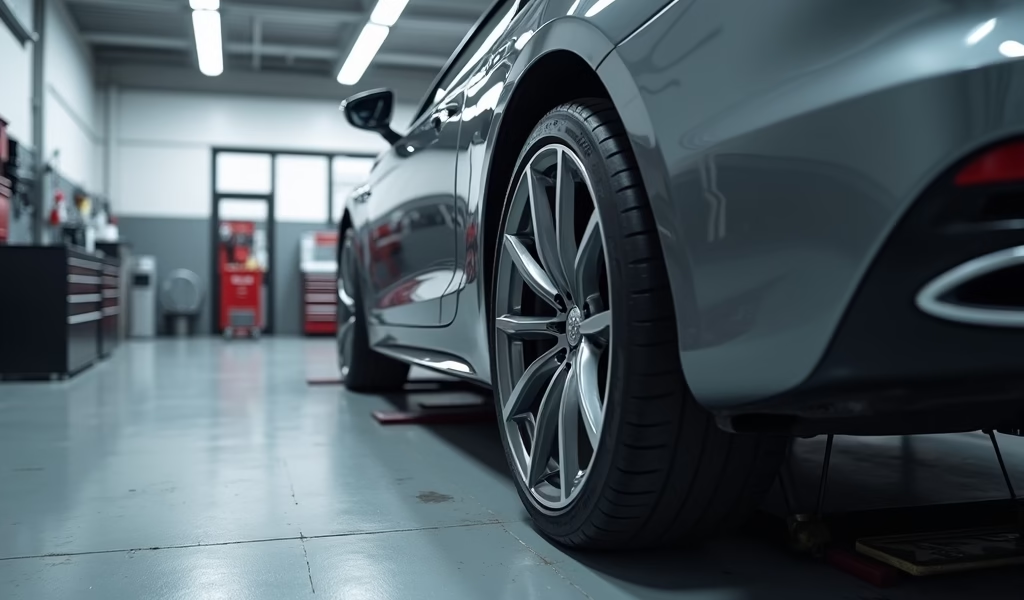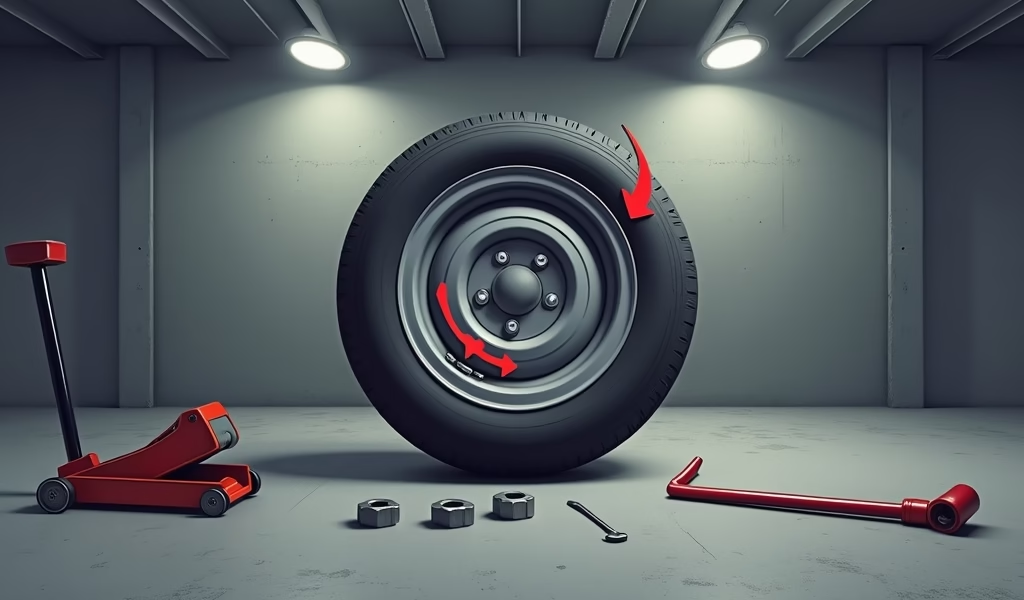Overview
This guide explains how to properly mount directional tires by following the sidewall arrows, which ensures optimal performance, safety, and longevity. When tires are mounted correctly, they provide better handling, superior water evacuation, improved fuel efficiency, and longer tread life, while incorrect mounting leads to premature wear, poor performance, and potential safety hazards.
Table of Contents
- Introduction
- What Are Directional Tires?
- Why Tire Direction Matters
- Tools You’ll Need for Proper Tire Mounting
- Step-by-Step DIY Tire Mounting Guide
- Common Mistakes to Avoid
- Maintenance Tips After Installation
- When to Seek Professional Help
- Conclusion
- Frequently Asked Questions
Introduction
Ever glanced at your tire sidewall and spotted that little arrow? It’s not just decorative flair – that tiny directional indicator is actually a crucial piece of automotive engineering. I’ve spent 20 years as a mechanic, and you wouldn’t believe how many perfectly good tires I’ve seen ruined simply because they were mounted backward.
That tire mounting direction arrow is like your tire’s instruction manual compressed into a single symbol. When followed correctly, it ensures your tires deliver optimal performance, safety, and longevity. When ignored… well, let’s just say your wallet won’t thank you.
Think of directional tires like socks – they might technically fit on either foot, but wear them on the wrong one and you’ll have a bad time walking. Throughout this guide, we’ll cover everything you need to know about identifying, understanding, and properly mounting tires according to their directional arrows. No automotive degree required – just a little patience and the right information.
What Are Directional Tires?

Directional tires feature specialized tread patterns designed to rotate in one direction only. Unlike non-directional tires (which are the automotive equivalent of ambidextrous), directional tires have distinct V-shaped patterns that must point in a specific direction when mounted.
The dead giveaway is that arrow or triangle on the sidewall, often accompanied by words like “Rotation” or “Direction.” This arrow is essentially your tire’s North Star – follow it, and you’ll be headed in the right direction (pun absolutely intended).
Directional tires offer several distinct advantages:
- Superior water evacuation (think of those V-patterns as tiny rivers channeling water away)
- Enhanced grip in wet and snowy conditions (because hydroplaning is about as fun as a root canal)
- Improved stability at highway speeds (less white-knuckling when that semi passes you)
- Reduced road noise (for those who enjoy conversations or podcasts without shouting)
- Better fuel efficiency (your wallet and Mother Earth both appreciate this one)
To check if your tires are directional, simply look for that arrow on the sidewall construction. If you see it, congratulations – you have tires that need special attention during mounting. If not, you’ve got non-directional tires, which are more forgiving about their orientation.
Why Tire Direction Matters
Mounting tires correctly isn’t just me being picky after two decades in the shop – it fundamentally impacts your driving experience, safety, and the lifespan of those not-so-cheap rubber circles. Let’s break down why paying attention to that arrow is worth your time:
Performance and Handling: When directional tires are mounted correctly, they perform as designed, providing responsive steering and confident cornering. Mount them backward, and your car will handle with all the precision of a shopping cart with a wobbly wheel. I once had a customer complain about his “defective” sports car until I pointed out his backward tires – the difference after remounting was like night and day.
Hydroplaning Resistance: The V-shaped tread pattern is engineered to channel water away from the center, reducing hydroplaning risk. Reverse the direction, and instead of pushing water out, the tire tries to scoop it in – like trying to empty a boat with a bucket that has a hole in it. Not effective, and potentially dangerous.
Tire Longevity: Incorrectly mounted tires wear unevenly and prematurely. The tread faces stresses it wasn’t designed to handle, resulting in abnormal wear patterns. This can slash your tire’s lifespan by up to 30% – turning your $800 set of tires into very expensive mistakes.
Safety First: Most importantly, proper tire direction is a safety issue. Reduced traction in wet conditions, compromised stability, and unpredictable handling all increase accident risk. As I tell my apprentices, “Four arrows pointing right means everyone gets home tonight.”
According to a National Highway Traffic Safety Administration study, proper tire maintenance – including correct mounting – could prevent thousands of accidents annually. That little arrow is more important than it looks.
Tools You’ll Need for Proper Tire Mounting
Before diving into tire mounting, let’s gather the right tools. You wouldn’t try to bake a cake without measuring cups, and you shouldn’t mount tires without proper equipment. Here’s what you’ll need:
Basic Tools:
- Jack and jack stands (please, for the love of all things mechanical, don’t rely solely on a jack)
- Lug wrench (the one that came with your car works, but a 4-way wrench is easier)
- Tire pressure gauge (digital ones are more accurate, but any gauge is better than none)
- Valve core tool (costs about $5 and saves endless frustration)
- Soapy water solution (dish soap and water in a spray bottle works perfectly)
Advanced Tools (for the ambitious DIYer):
- Torque wrench (not using one is like playing Russian roulette with your wheel studs)
- Bead breaker (if you’re removing tires from rims)
- Tire spoons or tire irons (for the truly determined home mechanic)
Safety Equipment:
- Work gloves (because band-aids don’t grow on trees)
- Safety glasses (your eyes are irreplaceable; that chunk of rust isn’t)
- Wheel chocks (because rolling cars make for bad days)
- Sturdy work surface (your driveway is fine; soft dirt isn’t)
Remember: Having the right tools isn’t just about convenience – it’s about safety and preventing damage to your tires and wheels. If you don’t have specialized equipment like tire mounting machines, you might want to consider having a shop mount the tires to the rims, then handling the wheel installation yourself.
I once had a customer use a screwdriver and hammer as improvised tire spoons. The resulting damage cost him more than if he’d paid a professional in the first place. Don’t be that guy – he’s now a legendary cautionary tale in my shop.
Step-by-Step DIY Tire Mounting Guide

Now for the main event – let’s get those tires mounted properly! I’ll break this down into digestible steps even for folks who think a lug nut is a type of breakfast cereal.
Preparation Steps
1. Find flat, stable ground to work on and engage your parking brake. Working on an incline is how horror stories begin.
2. Chock the wheels opposite to the ones you’re working on. If you’re lifting the front right, chock the rear left. Physics doesn’t care about your confidence – secure that vehicle!
3. Loosen (don’t remove) the lug nuts before jacking up. Breaking those nuts loose is much easier when the wheel can’t spin freely.
4. Check your owner’s manual for proper jack points. Using the wrong spot can damage components or create an unstable lift. Your owner’s manual isn’t just for showing off your literacy – it contains valuable information!
Safely Removing Wheels
1. Jack up the vehicle and immediately secure it with jack stands. A car falling on you will ruin more than just your day.
2. Remove the lug nuts completely, keeping them in a secure container. The automotive gremlin that steals single socks also loves lug nuts.
3. Pull the wheel straight off the hub. If it’s stuck, give the tire a gentle kick with the heel of your foot (not the expensive wheels themselves).
Checking Direction Arrows
1. Locate the directional arrow on the sidewall. It might be small, but it’s the star of our show today.
2. Note which way the arrow points – this indicates the forward rotation direction when the vehicle moves forward.
3. Remember this simple rule: When mounted on the vehicle, the arrow should point upward when viewed from the outside of the car. This applies to both front and rear tires.
4. Mark your tires with chalk if needed to remember their positions, especially if you’re rotating multiple tires.
Mounting Wheels Back Onto the Vehicle
1. Line up the wheel with the hub, making sure the valve stem is easily accessible.
2. Push the wheel straight onto the hub. If it doesn’t slide on easily, check for misalignment – don’t force it!
3. Thread the lug nuts by hand in a star or cross pattern. Finger-tight is enough for now.
4. Lower the vehicle until the tire just contacts the ground (but still bears some weight on the jack).
5. Tighten the lug nuts with your wrench in the same star pattern. This ensures even pressure on the wheel.
6. Fully lower the vehicle and remove the jack.
7. Final tightening with a torque wrench to your vehicle’s specifications (found in your owner’s manual or from reliable online sources). Too tight can damage studs; too loose can lead to wheels coming off – neither makes for a fun day.
8. Double-check torque after driving 50-100 miles, as lug nuts can settle.
If you’re mounting tires onto rims yourself (which requires more specialized equipment), ensure you maintain proper tire direction during the mounting process. The tire’s direction arrow should align with the intended rotation direction once installed on the vehicle.
Common Mistakes to Avoid
In my years of fixing other people’s mistakes (and occasionally my own – we’re all human), I’ve seen these blunders repeatedly. Learn from others’ misfortunes:
Mixing Directional and Non-Directional Tires: This creates handling characteristics as predictable as a cat on caffeine. Stick with matching sets for best performance and safety.
Ignoring Rotation Patterns: Directional tires can only be rotated front-to-back on the same side. Want to cross-rotate? You’ll need to dismount and remount them to maintain proper direction – a detail many DIYers miss until their tires wear unevenly.
Over or Under-Torquing: Too tight can stretch studs, warp rotors, and make future removal a nightmare. Too loose can lead to wheels wobbling or worse, coming off entirely. The torque wrench isn’t optional equipment – it’s as essential as your morning coffee.
Overlooking Tire Pressure: Even perfectly mounted tires perform terribly when improperly inflated. Check pressure when tires are cold and adjust to the vehicle manufacturer’s specs – not what’s printed on the tire sidewall (which is the maximum, not the recommended pressure).
The “It Feels Right” Approach: I once had a customer who insisted on tightening his lug nuts until they “felt right.” His idea of “right” stripped three studs and cost him a tow truck call when his wheel nearly came off. Feelings aren’t a substitute for torque specifications.
Maintenance Tips After Installation
Congratulations! Your tires are properly mounted with their directional arrows pointing the right way. Now, let’s keep them performing at their best:
Rotation Schedule: Rotate directional tires every 5,000-7,000 miles, moving them front-to-back on the same side to maintain proper direction. This helps achieve even wear and maximum tire life.
Monthly Inspection: Take a quick walk around your car once a month to check for uneven wear, damage, or embedded objects. Five minutes of inspection can prevent blowouts and extend tire life considerably.
The Penny Test: Insert a penny into your tire tread with Lincoln’s head upside down and facing you. If you can see the top of Lincoln’s head, your tires have less than 2/32″ of tread remaining and should be replaced. Consider it Lincoln’s way of saving your life from beyond the grave.
Pressure Monitoring: Check pressure monthly and before long trips. Temperature changes significantly affect pressure – a 10°F drop can lower pressure by 1-2 PSI. Underinflated tires wear faster, reduce fuel economy, and increase blowout risk.
Seasonal Considerations: If you swap between summer and winter tires (which is smart in many climates), always double-check directional arrows during changeovers. Nothing says “I wasted money” quite like mounting your expensive winter tires backward right before the first snowfall.
When to Seek Professional Help
DIY is great (and I fully support mechanical self-sufficiency), but sometimes calling in the pros makes sense. Here’s when to wave the white flag:
Complex Situations:
- Run-flat tires with their ultra-stiff sidewalls require specialized equipment most garages don’t have
- Low-profile tires are more prone to damage during amateur mounting attempts
- Expensive or rare wheels – is saving $50 worth risking your $2,000 wheels?
- TPMS (Tire Pressure Monitoring System) complications, which often need reprogramming after tire work
Warning Signs:
- Vibration after mounting that wasn’t there before
- Visible damage to tire beads or rims
- Air leaks that persist despite your best efforts
- Unusual noises that developed after your tire work
Remember, there’s no shame in seeking professional help. I may be a mechanic, but I still call a plumber when my pipes leak. Know your limits – professionals have tools and experience that make certain jobs safer and more efficient.
A friend once decided to mount his own low-profile tires to save money. After damaging two expensive tires and one rim, he sheepishly brought everything to my shop. The money he “saved” would have paid for professional mounting about eight times over. Sometimes the cheapest option is paying someone else to do it right the first time.
Conclusion
That little tire mounting direction arrow may seem insignificant, but it represents the difference between optimal performance and premature tire wear. When followed correctly, it ensures your tires channel water effectively, provide maximum traction, and wear evenly for thousands of miles.
Whether you’re a DIY enthusiast or simply want to understand what your mechanic is doing, knowing about directional tires empowers you to make better decisions about your vehicle’s maintenance. Remember: tires are your only connection to the road – giving them proper attention isn’t obsessive, it’s smart vehicle ownership.
The next time you’re looking at new tires or rotating your current set, take a moment to check for those directional arrows. Your vehicle will handle better, your tires will last longer, and most importantly, you’ll be safer on the road. That’s something worth paying attention to, even if it comes in the form of a tiny arrow on your tire sidewall.
And if all else fails? Well, there’s no shame in letting a professional handle it. After all, even mechanics don’t fix their own transmissions all the time (though we’ll rarely admit it). Drive safely, friends!
Frequently Asked Questions
What happens if I mount a directional tire backwards?
You’ll experience reduced wet traction, potentially dangerous hydroplaning, and accelerated uneven tire wear. The tire’s engineered benefits will be compromised, creating safety risks and shortening tire lifespan.
Can I rotate directional tires side to side?
Not without dismounting and remounting them on their rims to maintain proper rotation direction. Directional tires should typically only be rotated front-to-back on the same side of the vehicle.
Do all tires have direction arrows?
No, only directional tires have these arrows. Non-directional (symmetric) and asymmetric tires don’t have rotation direction arrows but may have inside/outside markings instead.
How often should I check my tire direction?
Check after any tire service, rotation, or seasonal changeover. A quick visual inspection takes seconds but prevents performance issues and premature wear.
Are directional tires better than non-directional ones?
Directional tires typically offer better wet performance and hydroplaning resistance but are less flexible for rotation patterns. The “better” choice depends on your driving conditions, vehicle, and personal priorities.

